
|   |

|   |
 e-mail: sunilkothari1933@gmail.com Paris diary: Milena Salvini, Centre Mandapa, and Shantala Shivalingappa August 13, 2016 Arriving in Paris after almost a decade, I was looking forward to meeting friends with whom I had spent lot of time during my former visits. The constants were Milena Salvini of Centre Mandapa, Savitry Nair and her husband Shivalingappa, and painter Velu Viswanadhan. Savitry and I go a long way as she hailed from Kalakshetra and we knew each other from early 60s. She has been in Paris for more than 40 years. She has played an important role by giving lec-dems, teaching, both classical Bharatanatyam and Carnatic music and working closely with France's legendary choreographer Maurice Bejart. She was instrumental in creating awareness about classical dance and music and Indian culture in France and Europe. 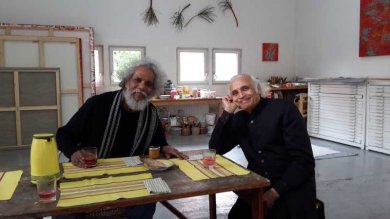
Sunil Kothari with artist Velu Viswanadhan in his Paris studio
I had informed few other friends about my illustrated talk on 'The Pioneers of Indian Dance' who placed it on the world map: Uday Shankar, Ram Gopal and Mrinalini Sarabhai with screenings of excerpts from film 'Kalpana,' a film made by Ayisha Abraham on Ram Gopal 'I saw God Dance' and Mrinalini Sarabhai's film 'The Artist and her Art' made by Mallika Sarabhai and Yadavan Chandran. Milena Salvini had arranged it on a Sunday amongst a crowded schedule at Mandapa and since soon after my talk a Bharatanatyam recital was scheduled by three French dancers, the place was humming with lovers of Indian dance and music. Kalpana, one of the French disciples of V.S. Muthuswamy Pillai, presented her two disciples Iran Farkhondeh and Fanny Wiard. Kalpana performed alarippu. She is tall and has a strong stage presence. Muthuswamy Pillai's style has set well on her. The lines were neat and clean, uncluttered and brought out the architectonic beauty of Bharatanatyam form. Kavutvam in Shanmukhapriya and eka talam was presented by Fanny. The sound training was seen in her execution. Iran performed varnam in Ananda Bhairavi and adi and Kalpana gave explanation on the content of the varnam in French to which Iran demonstrated with hastabhinaya and mukhajabhinaya. I was much impressed by the animated expressions of Iran and appreciation by the full house audience who at the end of the varnam went on clapping for quite a long time. Fanny presented padam "Yaarukkaagilum" taught to Kalpana by Sangeeta Isvaran in raga Begada and in misra chapu tala. The carefree expressions of the nayika, I do not care, came through succinctly. In "Kaalai thooki" in Harikamboji and adi tala, Fanny displayed her tandava aspect with complete command over the technique. 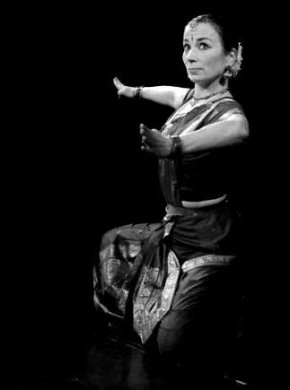 Kalpana 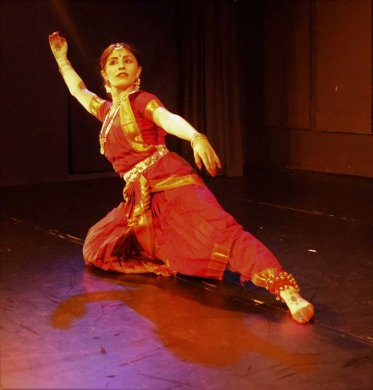 Iran Farkhondeh 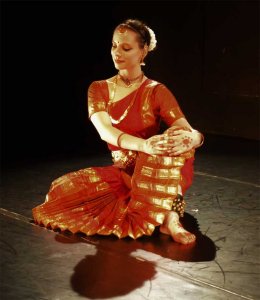 Fanny Wiard 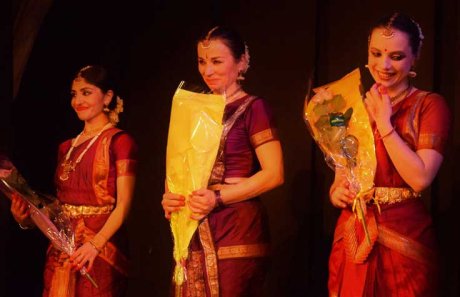 Iran, Kalpana and Fanny As a tribute to Kalanidhi Narayanan, who had passed away in February, Kalpana presented javali "Smara sundaranguni" in Paras and adi tala, bringing out her mature abhinaya skills reminding me of Kalanidhi's style. The finale Tala Vadyam in pancha nadai was executed perfectly by Kalpana, Iran and Fanny to a rousing reception from the audience. To recorded music of high quality, the neat presentation was indicative of French dancers' devotion to both gurus who had a large number of French disciples. For the duration of the recital, I was indeed transported to Chennai. I met Annette Leday, the French dancer specialising in Kathakali, whose intercultural work I had seen in Monte Carlo. Based on the story of Cindrella, Cendrillon Ailleurs, she had collaborated with two male Kathakali dancers who play female roles using Kathakali and modern dance technique. Annette told me that she was planning a tour in India. Milena's insistence on presenting classical Bharatanatyam in its traditional mould was evident in presenting Kalpana and her disciples. It was obvious that those who love classical dance and music find at Mandapa, a venue which offers them the rich classical fare. Milena did tell me in an aside, that she dislikes Bollywood dance and would never present it at Mandapa! Centre Mandapa Milena Salvini is herself an institution. Her dedicated services to popularise classical Indian dance forms, mainly Kathakali, Kutiyattam, Kalaripayattu, Thullals, Bharatanatyam, Kathak, and Purulia Chhau have been well recognized. Now she has extended the range for other cultures. I used to visit Mandapa regularly as Kamadeva used to teach Bharatanatyam there during his stay in France and I would sometimes stay with him. Milena and I had met earlier in Kolkata, but our main meeting was in Purulia village in 1971, when I was conducting research in Purulia Chhau dances about which I had come to know after publication in December 1968, of my first special issue of Marg on Chhau Dances of India. Jiwan Pani had worked on Mayurbhanj Chhau form and I on masked dances of Seraikella. Prof. Ashutosh Bhattacharya brought Purulia Chhau to Sangeet Natak Akademi in Delhi in1970, when I was in Paris. On return I planned to go to Purulia village in West Bengal with my photographer friend Subodh Chandra. Milena was also visiting Purulia village. We documented the form, its technique, performances and masks. The demonic energy with which the dancers performed was electrifying. Milena by then was planning to bring the form to Paris. It happened in 1972 when the troupe was visiting London. I was in Paris and saw the performances outside Paris, at Cartoucherie, where Milena had recreated the open arena as the dancers create in Purulia village. From Paris, the troupe went to London at Sadler's Wells, under the leadership of Prof. Ashutosh Bhattacharya and it took London by storm. Milena established Centre Mandapa at Rue Wurtz in Paris in 1975 with the help of her husband Roger Filipuzzi. They loved Kathakali and Kutiyattam immensely. Roger has made short films on Kathakali, Kutiyattam and other performing arts of Kerala. 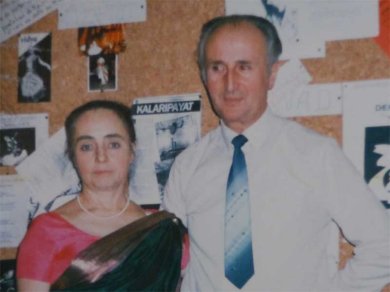 Milena Salvini and Roger Filipuzzi 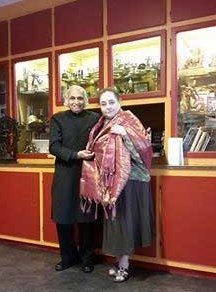 Sunil Kothari with Milena Salvini It was in 1964 that Milena Salvini had joined Kathakali class under Haridas Nair, son of Kunju Kurup. The same year she met Adyar K Lakshman and was drawn to Bharatanatyam. She received a fellowship and studied Bharatanatyam for two years under him. In 1966, she met M.K. Saroja in Delhi and studied under her as well and arranged for her adopted daughter Maria-Kiran to learn Bharatanatyam under Saroja. And a lifelong friendship developed between Milena, Mandapa and Saroja. Saroja's French disciple Vidya at behest of Malavika, another French dancer, a disciple of Elappa Pillai, started teaching Bharatanatyam at Mandapa, which she continues to teach even today. Milena in order to master Kathakali had gone to Kerala Kalamandalam receiving a fellowship from French Govt for a period of 8 months. As a matter of fact, Milena's heart is in Kathakali. Between 1980 and 1999, Milena presented several productions of Kerala Kalamandalam in Paris. She also invited Margi Madhu's troupe to perform Kutiyattam at Mandapa. Milena met Mani Madhav Chakyar and Painkulan Rama Chakyar and the latter specially came to inaugurate the department of Kutiyattam at Mandapa. Milena is extremely conservative in her artistic tastes and she strives to produce only authentic productions. For her dedication and services to classical arts of India, she has been honoured by the French Government with Chevalier of Arts and Letters. Many other awards have been bestowed upon her, including the Honour from Indian Council for Cultural Relations, Government of India. Over the years, Mandapa has become an integral part of all visiting dancers and musicians from India and many of them have performed on the small stage of Mandapa. Now Mandapa has expanded its activities and workshops are also held in Tai Chi Chuan, Arabo-Andalusian music, Chantas of Azerbaijan, Mugham traditions. Yoga classes are also held regularly. Not so big in terms of area and space, the intimacy of Mandapa is what brings artists together. Milena told me that since 1978, she has been arranging more than 200 shows annually. First time she had organized great epic nights, outsized musical cycles, 24 hours of Raga in 1985 at the Odeon and in 2000 at Theatre du Soleil. People remember those nights even today with great fondness. From 1985 to 2005 Milena hosted annual festival of 'Solo Without Borders' on the small stage of Mandapa, which was a huge success. She is ably assisted by her young daughter Isabel Anna, who has studied Kathak under Birju Maharaj's son Jaikishan Maharaj. After my talk, Milena spoke warmly about our long association and gave me souvenirs of Mandapa, its history and detailed recordings of Kathakali. In Paris, she is one of my very dear friends and I was deeply touched by her arranging my illustrated talk and screenings. Shantala Shivalingappa My accommodation was arranged at Shantala Shivalingappa's modest and nice apartment. Daughter of Savitry Nair and Shivalingappa, I had seen her perform Kuchipudi at Avignon Festival in 1995, when the focus was on India. Her posters were splashed all over Paris in Metro stations. Her teacher Vempati Chinna Satyam, his son Vempati Ravi and musicians were participating in the festival. Shantala was then 20 and had mastered both Bharatanatyam and Kuchipudi under Savitry, who had studied under Vempati Chinna Satyam. So later on, Shantala concentrated on Kuchipudi studying in Chennai at Kuchipudi Art Academy. The 1995 Avignon Festival was a most memorable festival with artist Raza's painting used as its logo. Meeting Savitry and Shiva, we recalled those exciting days of our meetings in Paris. When I visited Paris for the first time in 1968, I was asked to meet Mr. Arnaud Dejardins, a philosopher and a scholar, by Navnitbhai Parekh, my friend from Mumbai. I was at my friend Dileep's residence when a phone call came from Maurice Bejart from Brussels, asking Dileep to speak with me. Maurice told me that Arnaud Dejardins has asked Maurice to invite me as a dance critic of the Times of India to Brussels to meet him and attend Avignon Festival, where Maurice was to present his choreographic work titled 'Bhakti.' Savitry and Maurice were working together and Savitry was teaching at Maurice Bejart's Mudra institute in Brussels. I visited Brussels and saw his large group choreographic works on Nijinsky and Ninth Symphony. I was quite overwhelmed. Bejart was an unassuming and simple person, very friendly and warm. He invited me to Avignon, which was my fist visit there and it was fascinating to see so many performances there round the clock, at different venues. As a guest of Maurice, I was given all facilities. 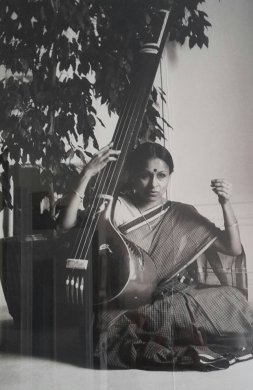 Savitry
Savitry used to take Shantala with her wherever she performed, took classes and conducted workshops. Born in Chennai, when she was barely one year old, Shantala moved to Paris with her parents and was brought up in an atmosphere full of music and dance. She studied Bharatanatyam from Savitry and soon acquired proficiency in it. She was barely 13 when seeing her talent, Maurice invited Shantala to participate in his production '1789... et nous' on the occasion of bi-centenary of French Revolution. Shantala had made comparative study of classical ballet and Bharatanatyam. She could pick up ballet movements and since the ballet was representing all nations, she represented India. This was the first major break she had in an international production. Savitry was helping Peter Brook also and for Mahabharata, her son was an understudy for child asking questions to Vyasa, the role which in final version Akram Khan played. Peter Brook's assistant had noticed young Shantala and recommended to cast her in role of Miranda, for Shakespeare's play The Tempest. She was 13, and for Miranda's role Peter found her perfect. The exposure to Peter Brook's training and vast cast helped Shantala to develop her acting skills. And when she was 23, Peter Brook once again cast her in role of Ophelia in 'The Tragedy of Hamlet' play. She had matured enough within ten years. Performing with international cast including Adrian Lester, Natasha Parry, Naseeruddin Shah and Rohan Siva, she developed confidence. The play was performed widely in different countries including US, Europe and Japan. It was an experience Shantala values the most. In 1999 Pina Bausch, whom Savitry had known, asked Shantala to perform as a guest dancer in her production 'O Dido.' Her professional association started with Pina Bausch from then on, which was another benchmark in her career. Pina had seen Vempati Chinna Satyam and Shantala perform at Avignon in 1995 and admired Vempati's dance style. Pina created a solo 'Ibuki' for Shantala at Tanztheatre at Wuppertal, with music by Ferran Savall. Working with Pina in 'Nefes' and 'Bamboo Blues,' Shantala learnt a lot about movement from viewpoint of this legendary choreographer. And she considers herself lucky to have performed in her company, when Pina was alive. I had seen her perform in 'Bamboo Blues' twice when it was staged at Siri Fort in New Delhi. And had marvelled at the ease with which she had adapted herself to Pina's choreography. 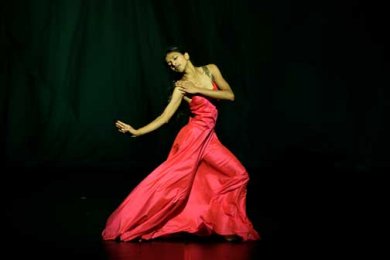 Shantala in Bamboo Blues Photo: Jond Duk Woo 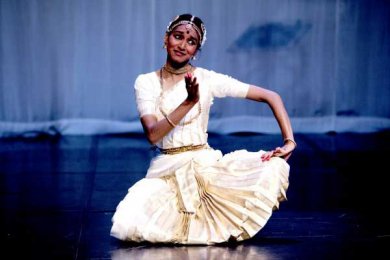 Shantala in Swayambhu Photo: Hector Perez Along all these activities, her love for Kuchipudi was abiding. Her arangetram in Kuchipudi was held at Kalakshetra in 1993. Shantala credits Savitry for the eclectic paths her career has taken. She has been put within milieu of Western Theatre and art as well as classical Indian dances, performing mostly before Western audiences. She has choreographed on her own and with guidance of her mother, several works in Kuchipudi. For 'Shiva Ganga' she won the prestigious Bessie award in New York for outstanding performance in 2013. The eclectic paths which Shantala mentions include her acting in classical French play 'Surena' by Corneille. No wonder with such challenges Shantala speaks French, Spanish, Italian and English fluently and is well versed in Tamil, Telugu, Malayalam and a little Kannada. With another well known director Bartabas, she performed for three years a solo dance in Zingaro Company's exotic 'Chimere' which travelled internationally. 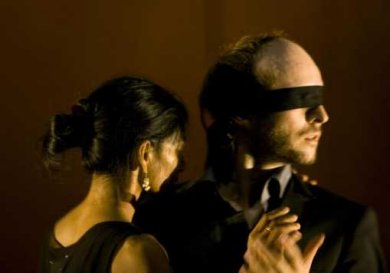 Shantala with Sidi Larbi Cherkaoui in 'Play' In 'Peer Gynt' directed by Irina Brook, she acts, dances and sings. Her latest collaborations have both been in Barcelona and it closely weaves together movement and music. The range and variety are fascinating and Shantala seems to be at ease in all these genres. She has performed in all major dance festivals including Jacob's Pillow in USA, but within India she is not so well known. She says the systems in the performance world in West are different from those in India. In India one has to approach the organizers, one has to know them, someone has to recommend the dancer and there has to be a long wait. She is not used to it and finds it comfortable to live in the West and perform professionally. She would love to perform in India any day, as she knows the audience is conversant with the myths, the music and the technique of dance and the rasikas applaud talent. With a successful career her calendar is full for next two years. It was indeed a pleasure to connect with her after 2013 and see her at the height of her career. Off stage she is slighter than she appears on stage and is impeccably polite, speaks in a crystalline delicate voice in a vocabulary as precise as her dancing and is quick to laughter. I shall cherish for long, my visit to Paris and knowing more about her artistic career.  Dr. Sunil Kothari is a dance historian, scholar, author and critic. He is honored with Padma Shri, Sangeet Natak Akademi award and Senior Critic Award from Dance Critics Association, NYC. Post your comments Please provide your name and email id when you use the Anonymous profile in the blog to post a comment. All appropriate comments posted with name & email id in the blog will also be featured in the site. |